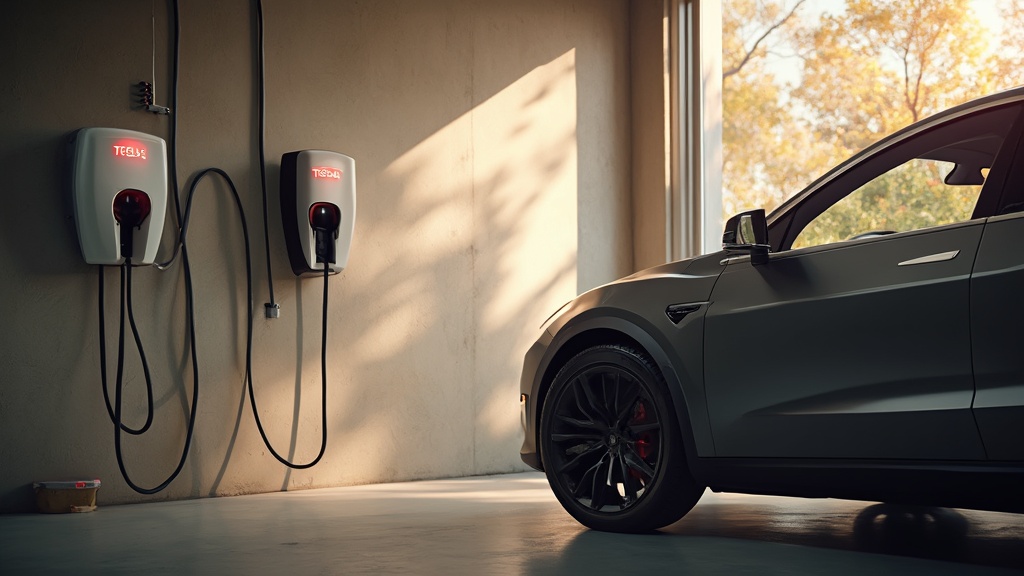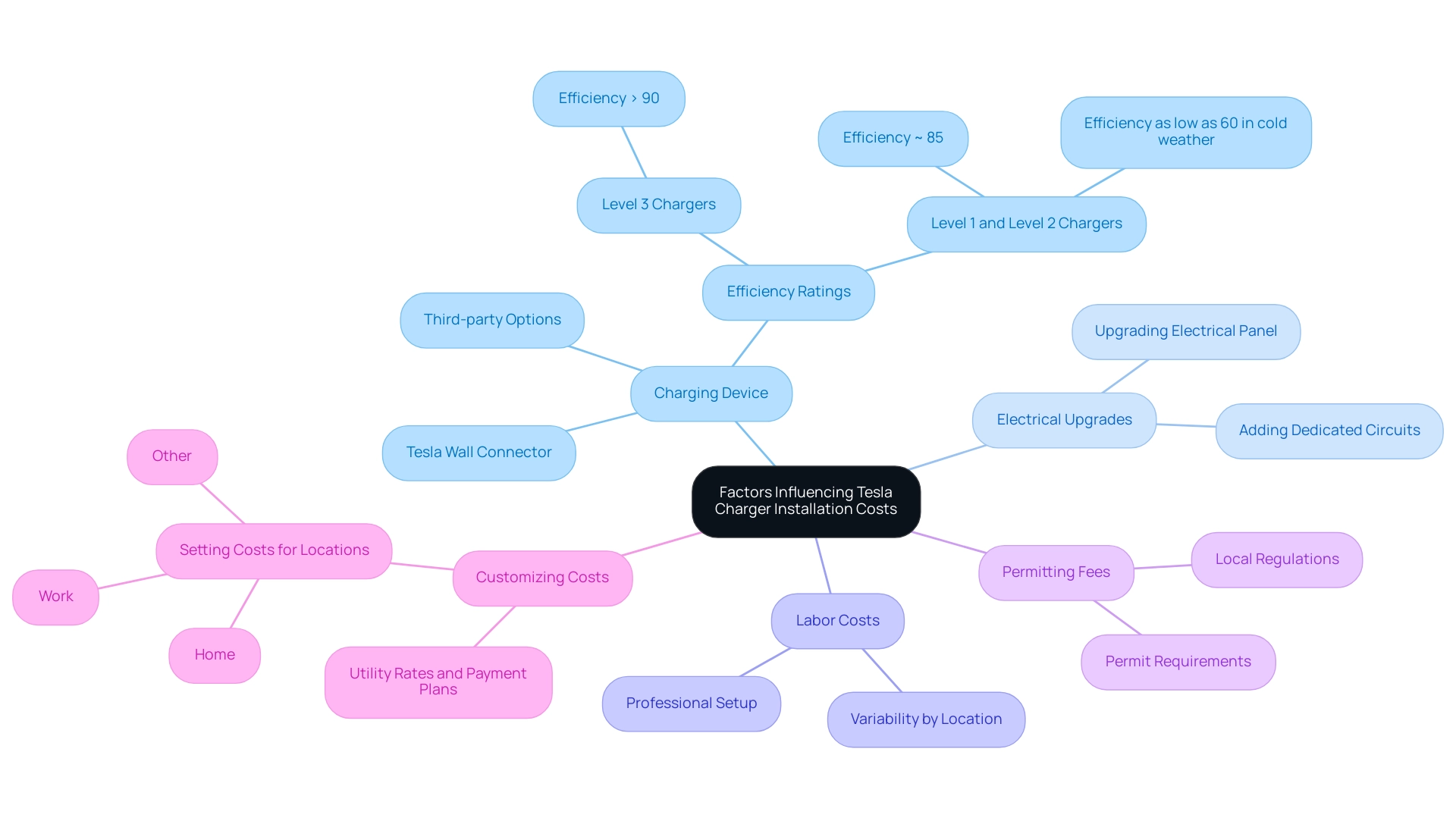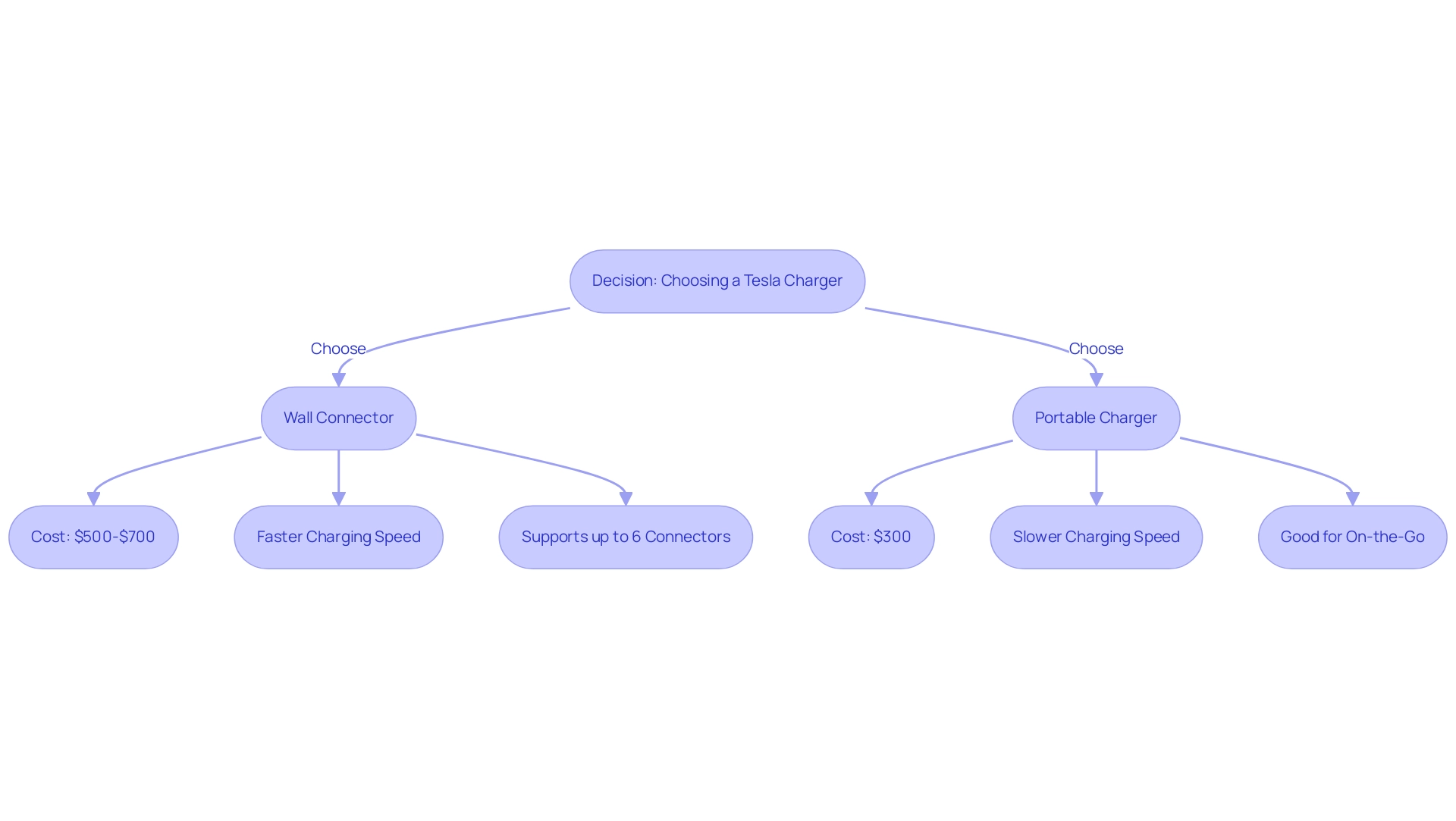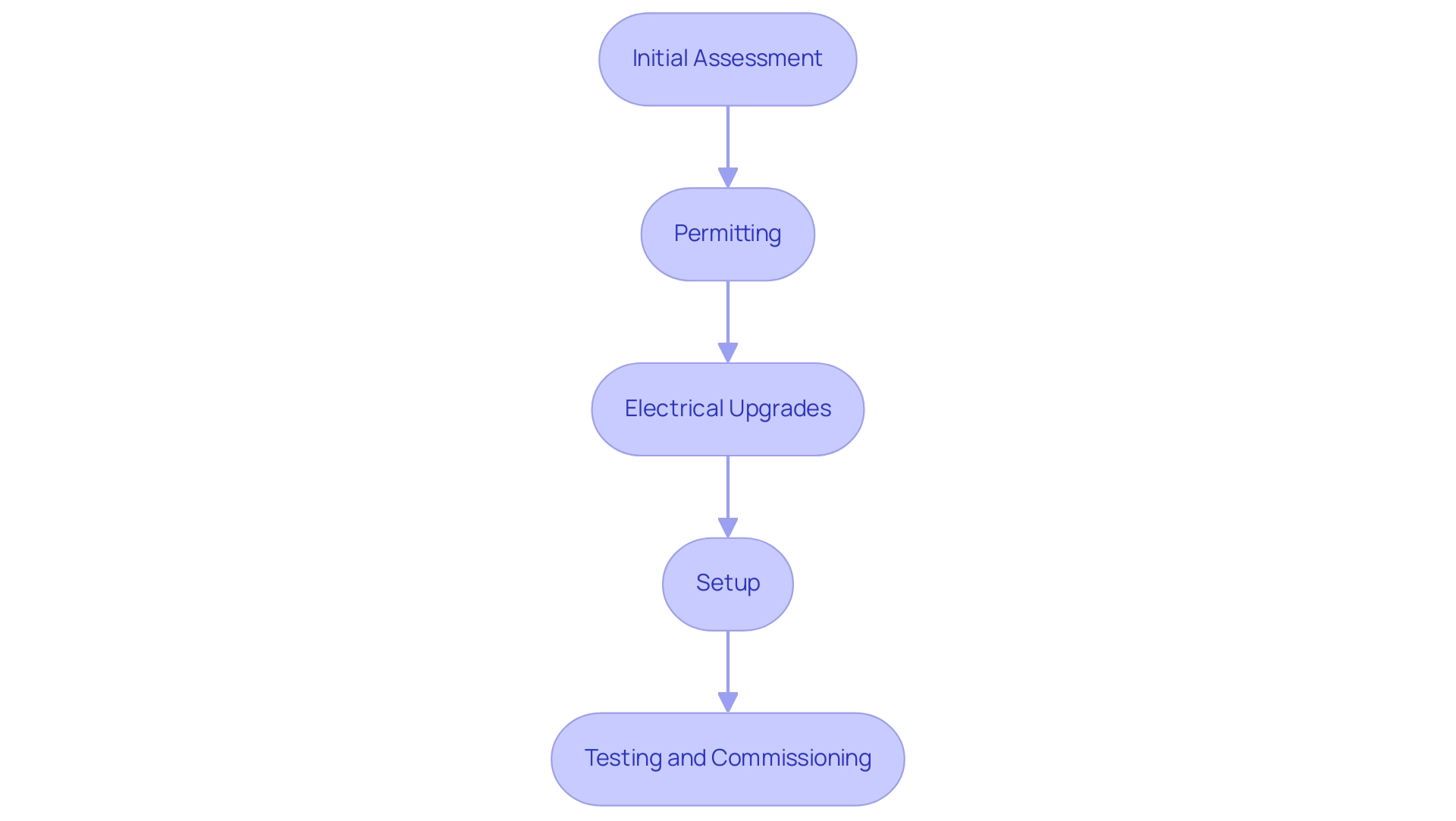Introduction
Considering a Tesla charger installation at home? It’s a decision that not only supports a sustainable lifestyle but also brings with it a range of costs and considerations that every homeowner should understand. From the type of charger chosen to the necessary electrical upgrades, the expenses can vary significantly, often falling between $500 and $3,000 or more.
This article delves into the essential factors influencing installation costs, the different types of chargers available, and the potential savings through federal and state incentives. With a clear understanding of the installation process and available resources, homeowners can make informed decisions that align with their eco-friendly goals while maximizing the benefits of their investment.
Whether it’s integrating solar energy solutions or navigating local rebates, this guide aims to empower homeowners in their transition to electric vehicle ownership.
Understanding Tesla Charging Installation Costs
For homeowners considering a Tesla power supply setup, it’s essential to prepare for the Tesla charging installation cost, which could range between $500 and $3,000 or more. This variation primarily relies on several critical elements, including the selection of power supply and the specific circumstances of your setup. If you opt for the Universal Wall Connector, which boasts a generous cable length of 24 feet, your setup might be more straightforward and thus more affordable.
Basic setups typically fall on the lower end of the Tesla charging installation cost spectrum, while more intricate configurations—especially those requiring electrical upgrades to accommodate the charger—can elevate the Tesla charging installation cost significantly. Understanding these financial considerations is crucial as the landscape of EV ownership evolves. Furthermore, as you investigate sustainable energy options, it’s important to recognize how electric vehicle charging stations can enhance your home’s solar panel setup.
With possible incentives for residential power access, including purchase and setup rebates or reduced electricity rates, incorporating a solar energy system can improve your energy savings. Furthermore, electric vehicle charging stations provide features like:
- Tracking charging statistics
- Establishing access controls
- Obtaining remote diagnostics through the application
These features enhance the user experience. Homeowners can also gain from government initiatives that encourage the setup of EV stations and solar panels, as well as from premier cleaning services that ensure solar panel efficiency.
By familiarizing yourself with these potential costs, such as the Tesla charging installation cost, incentives, and available resources, you can effectively plan your budget, making the transition to electric vehicle ownership smoother and more financially manageable while maximizing the benefits of your solar energy investments. Furthermore, understanding the functionality of solar panels and battery storage solutions can provide additional insights into optimizing your energy system.
Factors Influencing Tesla Charger Installation Costs
When considering the installation of a Tesla charger, several key factors will impact your overall costs:
- Charging Device: The first decision revolves around the type of charging device you choose. Whether you opt for the Tesla Wall Connector or a third-party option, prices can vary widely. Each type brings its own set of features and efficiencies—Level 3 chargers, for example, can achieve efficiency ratings above 90%, while Level 1 and Level 2 chargers typically reach about 85%, and some may drop to as low as 60% in cold weather, as noted by Car and Driver. This efficiency is particularly important given that the average distance driven according to the Department of Transportation is 13,476 miles each year, highlighting the need for effective charging solutions.
- Electrical Upgrades: Before proceeding with the setup, it’s essential to assess your home’s electrical system. If it falls short of handling the power needs of a charger, you may need to invest in electrical upgrades. This could range from upgrading your electrical panel to adding dedicated circuits, which will significantly influence your Tesla charging installation cost.
- Labor Costs: Hiring a professional for the setup is highly recommended for ensuring safety and compliance with local codes. Keep in mind that labor rates can vary by location, so it’s wise to get multiple quotes from local electricians to understand the Tesla charging installation cost. Many professionals underscore the significance of proper setup to maximize efficiency and safety.
- Permitting Fees: Depending on where you live, local regulations may require permits for installation. These fees, including the Tesla charging installation cost, can add to your overall expense, so it’s a good idea to check with your local authorities about necessary permits before moving forward.
- Customizing Costs: Additionally, users can manually set expenses for different locations (Home, Work, Other) to gain accurate insights into their savings and costs, as illustrated in the case study titled “Setting Costs.” By personalizing their utility rates and payment plans, users can enhance their strategy and potentially boost their savings.
By understanding these factors and recognizing the significance of regular maintenance for solar panels—where accumulation of dust, dirt, and debris can result in a decrease of up to 25% in efficiency—you’ll be better prepared to budget for your Tesla charging installation cost and ensure that your solar investment remains efficient and effective. Professional cleaning services not only utilize specialized equipment that can prevent potential damage to the panels but also help extend the lifespan of solar systems by addressing issues before they escalate. Whether you choose to maintain your solar panels with innovative cleaning solutions or hire professionals, embracing these practices will support a sustainable lifestyle and enhance your eco-conscious decisions.
Types of Tesla Chargers and Their Costs
When evaluating home power options for your electric vehicle, it’s crucial to investigate two primary categories:
- Wall Connector: This option is a favorite among electric vehicle owners for good reason; it delivers faster charging speeds, making it perfect for daily use. The tesla charging installation cost typically ranges from $500 to $700, influenced by installation specifics and any additional features you may choose. Impressively, the Wall Connector can support up to 6 connectors on the same circuit breaker, making it a versatile choice for households with multiple electric vehicles.
- Portable Charger: If you’re looking for a more budget-friendly option, Tesla’s mobile connector is priced around $300. While it’s convenient for on-the-go power replenishment, keep in mind that it offers slower speeds, which may not be the best fit for your daily needs.
As you consider your options, reflect on your driving habits and how often you’ll be replenishing at home. If you have a designated area for power supply, investing in the Wall Connector could be a wise choice for that speedy recharge. Plus, as Copernicus highlights, the savings from using a Wall Connector compared to traditional internal combustion engine (ICE) vehicles can be quite significant, with a cost difference of 29%.
While permits for installation are often seen as optional, securing one can offer peace of mind regarding the tesla charging installation cost in case any issues arise down the road. Along with the power solutions, it’s important to consider how integrating solar energy options can enhance your overall energy efficiency. Government programs may provide incentives for homeowners looking to install solar panels, which can work in conjunction with your Tesla charger to reduce energy costs further.
A contemporary garage outfitted with solar panels not only meets your electric vehicle power requirements but also aids in a sustainable lifestyle by utilizing renewable energy. Ultimately, your decision should align with your lifestyle and the level of convenience you seek in your charging routine, ensuring that you make the most of your eco-friendly investment.
Exploring Savings and Incentives for Tesla Charger Installation
As an eco-aware homeowner, you’ll be pleased to know there are several savings opportunities that can make the setup of your Tesla device much more affordable:
- Federal Tax Credit: For setups completed by the end of 2022, you could deduct 30% of the setup cost from your federal taxes, with a maximum total credit of $30,000 for depreciable property and $1,000 for other property. This significant credit can greatly help in reducing your overall expenses.
- State Rebates: Many states have incentive programs for electric vehicle charging installations. For instance, California offers rebates that can reach up to $1,000 to help offset your costs. It’s worth checking what your state has in place!
- Local Utility Incentives: Your local utility provider may also offer additional rebates or reduced rates for electricity use during off-peak hours, which can further enhance your savings.
Additionally, as noted in recent discussions about solar energy solutions, major automakers like BMW are planning to build an extensive EV power station network across North America, with the goal of developing at least 30,000 stations. This growing infrastructure is supported by an investment of $7.5 billion, ensuring that charging EVs is predictable, reliable, and accessible.
Moreover, exploring other solar energy solutions can further enhance your eco-friendly efforts. For instance, comprehending how solar panels function on your home can result in extra savings on your energy costs, while investing in solar battery storage options can assist you in optimizing your energy efficiency.
As you investigate these possible savings and the changing infrastructure, investing in an electric vehicle charging station can become a wise financial choice, especially when considering the Tesla charging installation cost. Don’t miss out on these opportunities to save while making your home more eco-friendly! With the correct information, you can explore the terrain of electric vehicle charging stations, solar panel performance, and governmental initiatives to optimize your advantages.
The Installation Process: What Homeowners Need to Know
Installing an electric vehicle charging station in your residence can be an uncomplicated task, particularly when you understand what to anticipate. Here’s a friendly breakdown of the typical setup steps:
-
Initial Assessment: First things first, our team at Powercore Electric will conduct a thorough evaluation of your property to determine the optimal placement for your Tesla charging station and assess the tesla charging installation cost related to your electrical system. This evaluation assists in customizing the setup plan to meet your specific needs.
-
Permitting: Don’t worry about the paperwork! Your installer will take care of any permits needed according to local regulations, ensuring everything is above board.
-
Electrical Upgrades: If your current electrical infrastructure requires some enhancements, we may carry out necessary upgrades to support the device, ensuring optimal performance.
-
Setup: The actual setup is usually a quick process, often taking just a few hours. During this time, your charger will be mounted securely, and the wiring will be connected to your electrical panel. Interestingly, many electricians can complete the setup without turning off the main power. One user, Cosmacelf, described their experience, noting,
When my electrician did mine, he wired everything up first, so that the breaker was the last connection. He did not turn the power off on the panel. He just clipped the breaker in, made sure it was off, then hooked the wires to it. This approach can make the setup even smoother! It’s worth noting that in both home setups, the electricity was out for a duration brief enough to not be noticed, which reassures homeowners about the minimal disruption during the process.
-
Testing and Commissioning: After setup, we rigorously test the power station to ensure it’s functioning optimally and meets all safety and regulatory standards. A final inspection may also be necessary to ensure that all safety standards are met, providing you peace of mind knowing your device is safe and ready to use.
Additionally, many users recommend the Wall Connector over a NEMA 14-50, emphasizing its efficiency and benefits such as quicker charging times and improved integration with your electric vehicle. This recommendation highlights the benefits of choosing the Wall Connector for homeowners, and by familiarizing yourself with these steps, you can feel more prepared and at ease with the installation of your Tesla charger, including understanding the tesla charging installation cost.
Conclusion
Investing in a Tesla charger installation at home is a significant step toward embracing a sustainable lifestyle and enjoying the convenience of electric vehicle ownership. Understanding the costs involved—ranging from $500 to $3,000 or more—along with the factors that influence these expenses, such as charger type and necessary electrical upgrades, is crucial for homeowners. The choice between a Tesla Wall Connector and a portable charger can impact both your budget and daily charging efficiency, making it essential to consider your specific needs.
Moreover, the potential savings through federal and state incentives can greatly offset installation costs. Homeowners can take advantage of tax credits, rebates, and reduced utility rates to make this eco-friendly upgrade more financially manageable. With the right approach, integrating a Tesla charger with solar energy solutions can lead to further savings and enhance energy efficiency, creating a win-win scenario for both the environment and your wallet.
Ultimately, the installation process is straightforward and can be made even easier with the help of professionals who understand local regulations and safety standards. By taking the time to assess your options and plan accordingly, homeowners can enjoy the benefits of electric vehicle ownership while contributing to a greener future. Embracing these technologies not only supports personal eco-conscious goals but also aligns with the broader movement toward sustainable living.





